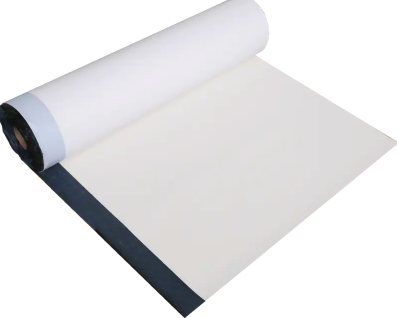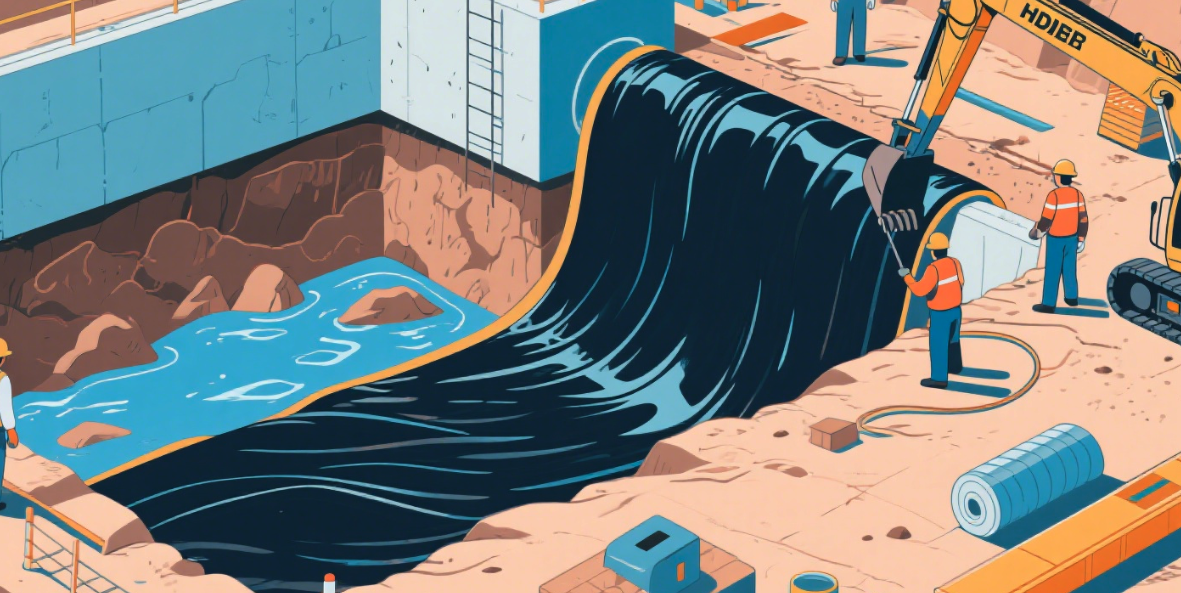HDPE Membrane Waterproofing is your go-to solution for keeping basements, roofs, and tunnels dry, no matter the weather. Using high-density polyethylene sheets, this waterproofing method creates a strong, flexible barrier that resists water, chemicals, and UV damage. Curious about how HDPE geomembrane waterproofing works or if it suits your project? Let’s explore the benefits, types, and installation of HDPE waterproofing membranes to help you protect your structure confidently while reducing long-term maintenance costs.
HDPE, or High-Density Polyethylene, is a durable thermoplastic polymer. It forms a robust, flexible sheet. This sheet acts as a waterproof barrier. HDPE membranes resist chemicals, UV rays, and punctures. They are ideal for long-term waterproofing solutions.
HDPE membrane waterproofing creates an impermeable layer. This layer prevents water from passing through. The membrane is laid over surfaces. Seams are welded together. This forms a continuous, watertight seal. Water cannot penetrate this seal. It protects structures from moisture damage.
| Feature | HDPE Geomembrane | Traditional Membranes |
|---|---|---|
| Material | High-Density Polyethylene | Bitumen, PVC, EPDM |
| Durability | High | Moderate |
| Chemical Resistance | Excellent | Variable |
| UV Resistance | Excellent | Requires protection |
| Installation | Heat-welded seams | Adhesive or mechanical |
| Flexibility | High | Moderate |
| Cost | Moderate | Low to moderate |
HDPE geomembranes offer superior durability and chemical resistance. They outperform traditional membranes in harsh environments.

HDPE membrane waterproofing offers a range of compelling advantages that make it a preferred choice for modern construction and environmental protection projects. Its unique material properties provide long-term performance in demanding conditions.
HDPE membranes create a continuous, impermeable barrier that effectively blocks water infiltration. Their low permeability ensures reliable protection against moisture, even under hydrostatic pressure. This makes them ideal for basements, tunnels, and water containment structures.
Despite their strength, HDPE membranes remain highly flexible. This flexibility allows them to conform to uneven surfaces and accommodate structural movements without cracking. They maintain integrity over decades, reducing the need for frequent repairs or replacements.
HDPE is inherently resistant to a wide range of chemicals, including acids, alkalis, and solvents. This property makes it suitable for industrial applications where exposure to aggressive substances is common. It ensures the membrane remains unaffected by soil contaminants or industrial effluents.
HDPE membranes are formulated with UV stabilizers that protect them from degradation caused by prolonged sun exposure. This resistance extends their lifespan in exposed applications such as landfill caps or pond liners, where other materials might deteriorate quickly.
The robust nature of HDPE provides exceptional resistance to punctures and mechanical damage during installation and service. This durability is critical in applications where the membrane may come into contact with sharp objects or heavy loads.
HDPE is a recyclable material that does not release harmful substances into the environment. Its long service life reduces the need for replacement, minimizing waste. Additionally, its inert nature ensures it does not contaminate soil or groundwater.
By combining these advantages, HDPE membrane waterproofing delivers a reliable, sustainable solution for a wide range of waterproofing challenges.
Pre-applied HDPE membranes are installed before concrete is poured. They bond mechanically to the concrete as it cures. This creates a strong, continuous barrier. They are ideal for basements and tunnels. Installation is quick and efficient. They reduce the risk of water ingress significantly.
Post-applied HDPE membranes are installed after the structure is built. They are adhered or mechanically fastened to the surface. They are suitable for retrofit projects. They provide reliable waterproofing for existing structures. They are flexible and easy to install.
Fleece-backed HDPE membranes have a geotextile layer. This layer provides additional protection and stability. It enhances puncture resistance. It also improves adhesion to substrates. They are used in areas with high mechanical stress. They offer long-term durability.
HDPE membranes come in various thicknesses. Common thicknesses include 0.5 mm, 1.0 mm, 1.5 mm, and 2.0 mm. Thicker membranes offer greater durability. They are suitable for demanding applications. Material standards ensure quality and performance. They meet international specifications.
| Type | Installation Method | Key Features | Typical Use Cases |
|---|---|---|---|
| Pre-applied HDPE Membranes | Installed before concrete pour | Bonds to concrete during curing | Basements, tunnels |
| Post-applied HDPE Membranes | Adhered or fastened after construction | Flexible, easy to retrofit | Existing structures, repairs |
| Fleece-backed HDPE Membranes | Geotextile layer bonded to membrane | Enhanced puncture resistance, better adhesion | High-stress areas, green roofs |
| Thickness Variations | Available in 0.5–2.0 mm | Thicker = more durable | Varies by project demands |
The availability of HDPE membranes in different thicknesses allows for customization based on the specific requirements of a project. Thicker membranes provide enhanced durability and are better suited for applications where the membrane will be exposed to harsh conditions or where a longer service life is desired. Adherence to material standards ensures that the membranes perform reliably under a wide range of environmental conditions, providing peace of mind for engineers and contractors alike.

HDPE membranes are widely used in basements. They prevent groundwater from seeping into walls and floors. The membrane forms a continuous barrier. It protects the structure from moisture damage. Installation is straightforward. It ensures long-term dryness.
Foundations benefit greatly from HDPE membranes. They shield concrete from water ingress. This prevents cracking and deterioration. The membrane withstands soil pressure. It maintains integrity over time. It is essential for structural longevity.
Underground parking lots face constant water exposure. HDPE membranes provide reliable protection. They prevent water from entering the parking area. The membrane resists vehicle loads. It remains effective for decades. It reduces maintenance costs.
Flat roofs are prone to water pooling. HDPE membranes offer excellent waterproofing. They prevent leaks and structural damage. The membrane handles temperature changes. It remains flexible in cold weather. It is ideal for flat roof applications.
Green roofs support plant growth. HDPE membranes protect the building from root penetration. They prevent water damage. The membrane is environmentally friendly. It supports sustainable building practices. It ensures the roof’s longevity.
Balconies and terraces are exposed to weather. HDPE membranes provide durable waterproofing. They prevent water from entering the building. The membrane resists UV rays. It remains stable under foot traffic. It is perfect for outdoor spaces.
Tunnels and subways are vulnerable to water ingress. HDPE membranes create a robust barrier. They prevent water from entering the tunnel. The membrane withstands hydrostatic pressure. It ensures a dry environment. It is crucial for safety.
Underground environments demand strong waterproofing. HDPE membranes maintain structural integrity. They protect against water damage. The membrane resists soil chemicals. It remains durable over time. It is vital for underground structures.

Landfills require effective containment. HDPE membranes prevent leachate from contaminating soil and groundwater. They form a secure barrier. The membrane resists chemicals. It protects the environment. It is essential for waste management.
Swimming pools and water features need reliable waterproofing. HDPE membranes provide excellent containment. They prevent water loss. The membrane is safe for aquatic life. It remains durable in wet conditions. It is ideal for water features.
Proper preparation is crucial for a successful installation. First, clean the substrate thoroughly. Remove all debris, sharp objects, and contaminants. Ensure the surface is smooth and dry. Any irregularities can compromise the membrane’s integrity. Next, inspect the membrane for defects. Check for tears, punctures, or inconsistencies. Store rolls in a cool, dry place before use. This prevents premature degradation. Finally, gather all necessary tools and equipment. This includes welding machines, adhesives, and fasteners. Proper preparation ensures a seamless installation process.
Heat welding is the most common method for installing HDPE membranes. It involves using a hot wedge or extrusion welder. The welder heats the membrane edges to a molten state. Then, pressure is applied to fuse the sheets together. This creates a strong, watertight seam. The process requires skilled operators. They must maintain consistent temperature and pressure. Proper welding ensures long-term performance.
Adhesive application is suitable for certain substrates. It involves applying a compatible adhesive to the membrane and substrate. The adhesive must be evenly spread. Then, the membrane is pressed into place. This method is quick and easy. However, it may not be suitable for all environments. Adhesives can degrade over time. Regular inspection is necessary.
Mechanical fastening involves securing the membrane with fasteners. This method is often used in conjunction with other techniques. Fasteners must be corrosion-resistant. They should not penetrate the membrane excessively. Proper spacing is essential. This prevents stress concentrations. Mechanical fastening provides additional security.
Following best practices ensures a leak-free installation. First, overlap seams correctly. Overlaps should be at least 100 mm. This provides adequate bonding area. Second, weld seams in a continuous manner. Avoid interruptions. Third, inspect all seams thoroughly. Use vacuum or pressure testing. This identifies any defects. Fourth, protect the membrane from damage. Avoid sharp tools and heavy equipment. Finally, follow manufacturer guidelines. This ensures optimal performance. Proper installation guarantees long-term waterproofing.
HDPE membranes last because they resist chemicals, water, and UV rays. They flex under pressure, so cracks are rare. It is tough enough to handle sharp rocks and heavy machinery on site. This durability means less maintenance later. Many membranes use high-density polyethylene that stays stable for years, even underground.
Yes, it can. HDPE membranes can handle hot summers and freezing winters. They do not get brittle in cold or lose strength in heat. These membranes keep out water even if soil moves during freeze-thaw cycles. Contractors trust it in desert heat, tropical storms, and freezing temperatures.
HDPE waterproofing systems often last over 30 years if installed correctly. Their resistance to UV, chemicals, and tears helps extend their lifespan. They hold up well under soil pressure and water exposure. Routine checks for punctures or debris will help them work longer.
Upfront, HDPE membrane waterproofing may cost more than some coatings or cheaper liners. However, it saves money over time. It cuts future repair costs and water damage risks. With its long service life, many projects find it a cost-effective investment.
DIY installation is possible for small garden ponds or simple covers, but for basements, roofs, or tunnels, professional installation is best. HDPE sheets need precise welding and careful handling. Creases or gaps can cause leaks later. Contractors use heat welding and testing methods to ensure a tight seal.
Ready to protect your project from water damage for decades? HDPE membrane waterproofing offers unmatched durability and flexibility, even in harsh climates. It keeps structures dry while reducing maintenance costs, making it a smart, sustainable choice for basements, roofs, and tunnels.
If you want peace of mind on your next project, Jiangsu Canlon Building Materials Co., Ltd. can help. We provide high-quality HDPE membrane solutions and technical support, ensuring your structure stays protected. Reach out today to discuss your waterproofing needs.
Copyright 2024 Jiangsu Canlon Building Materials Co.,Ltd. All Rights Reserved. 苏ICP备11076726号-3